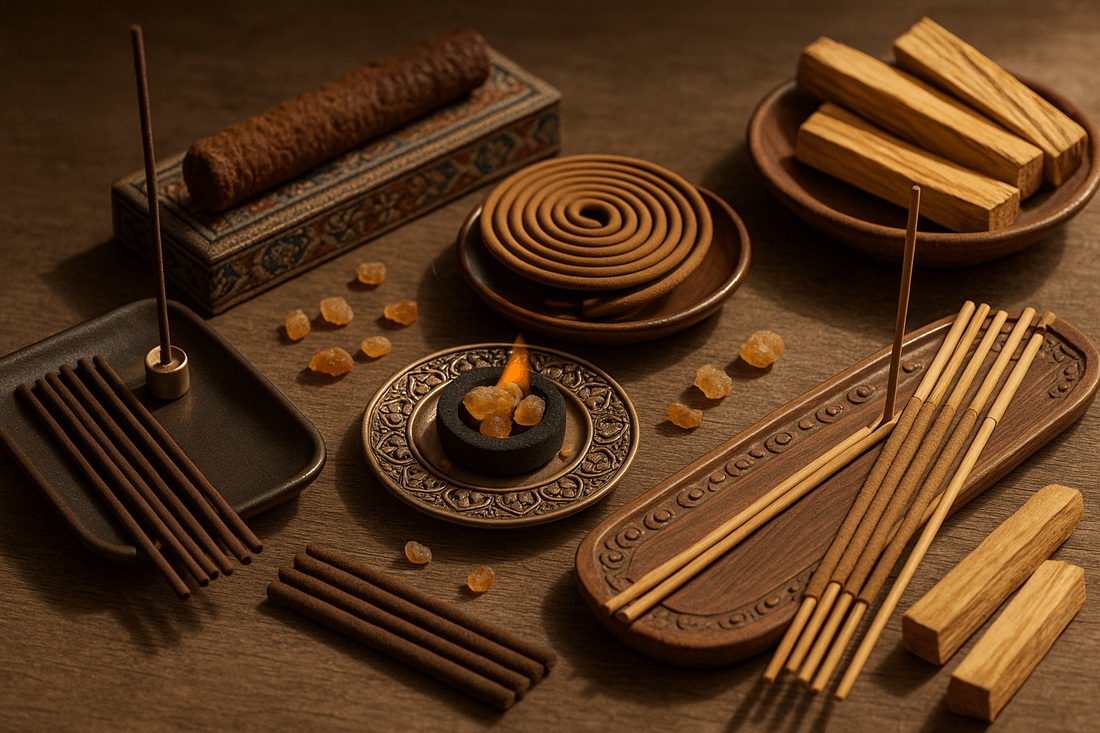
A World of Scent: Exploring Different Types of Incense Across Cultures
Incense has drifted through temples, homes, and sacred spaces for thousands of years. Though it takes many forms—sticks, cones, coils, loose resins—the purpose is often the same: to connect the human experience with something deeper. Whether it's prayer, purification, healing, or meditation, incense plays a quiet but powerful role across cultures.
In this post, we explore the many faces of incense across the globe—from the delicate woods of Japan to the rich resins of the Middle East—revealing how this timeless ritual bridges spirit, space, and scent.
Japan: Kōdō and the Art of Subtlety

In Japan, incense is more than aroma—it’s an artform. The traditional Japanese incense ceremony, called Kōdō (香道), literally means "The Way of Incense." It’s considered one of the three classical Japanese arts of refinement, alongside the tea ceremony and flower arrangement.
Japanese incense is typically coreless, meaning there’s no bamboo stick. It burns cleaner and with minimal smoke. Blends often include aloeswood (jinkō), sandalwood, clove, and cinnamon, mixed into finely ground pastes and extruded into thin sticks.
Reference: Morita, S. (1992). Kōdō: The Way of Incense in Japanese Culture. In Japanese Journal of Religious Studies, 19(1), 25–38.
Usage: meditation, seasonal ceremonies, poetry gatherings
Forms: coreless sticks (senkō), incense chips (used in Kōdō)
China: Fragrance in Philosophy and Ritual

In China, incense has long been used in Daoist, Buddhist, and Confucian traditions. It was burned in temples, homes, and even used by scholars during reading or calligraphy to measure time.
Chinese incense is usually made with herbs, woods, and traditional medicines, such as agarwood, sandalwood, borneol, and Chinese medicinal plants. Coils and sticks are most common, often with thicker forms than Japanese incense.
Usage: temple offerings, ancestral worship, spiritual protection
Forms: thick sticks, incense coils, loose blends for censers
Reference: Ho, P. Y. (1998). The Evolution of Incense Culture in China. Asian Folklore Studies, 57(2), 325–342.
India: Spiritual Smoke in Everyday Life

India is often considered the birthplace of incense as a spiritual tool. In Hindu rituals, incense (called “agarbatti”) is offered to deities, used in pujas, and burned in homes daily.
Indian incense sticks are typically made with a bamboo core, dipped into a paste of charcoal, wood powder, resins, and essential oils. Fragrances are rich and bold—jasmine, rose, patchouli, sandalwood, and champa are among the most iconic.
Reference: Parry, J. (1994). Death and the Regeneration of Life. Cambridge University Press. (Chapter on ritual smoke in Vedic practices)
Usage: daily worship, festivals, funerals, mood setting
Forms: bamboo-core sticks (agarbatti), dhoop (thick smokeless incense), cones
Nepal and Tibet: Earthy Offerings to the Divine

In Nepal and Tibetan Buddhism, incense is deeply symbolic—used to purify the mind and environment. It is often burned in monasteries, mountain retreats, and Himalayan homes.
Tibetan incense is handmade using over 30–40 medicinal herbs, including juniper, rhododendron, sandalwood, saffron, and myrrh. The scent is earthy, spicy, and grounding. It’s often used to accompany chanting, meditation, and prayer flags fluttering in the wind.
Usage: spiritual cleansing, ritual offerings, healing ceremonies
Forms: cones, coreless sticks, powdered incense for loose burning
Reference: Tashi, T. (2015). Traditional Tibetan Medicine and Ritual Use of Fragrant Plants. Himalayan Journal of Ethnobotany, 3(1), 47–56.
Middle East: Sacred Resins and Desert Smoke

In the Middle East, incense—especially frankincense and myrrh—has been traded, gifted, and burned for millennia. The practice originates in ancient Arabian and African trade routes, where resin was more valuable than gold.
Resins are burned over charcoal in ornate censers, often as part of Islamic, Christian, and regional folk practices. Omani frankincense (Boswellia sacra) is among the most prized in the world. The smoke is believed to purify the space, welcome guests, and connect with the divine.
Usage: prayer, hospitality, perfuming clothes and hair
Forms: raw resins burned on charcoal, bakhoor (wood chips soaked in oils)
Reference: Farah, M. H., et al. (2006). Medicinal and cultural use of frankincense and myrrh in Middle Eastern traditions. Phytotherapy Research, 20(4), 327–331.
South America: Sacred Smoke and Shamanic Healing

In Amazonian and Andean traditions, smoke is a vital part of cleansing ceremonies and plant medicine rituals. Native cultures in South America have long used incense in the form of burning herbs, woods, and resins.
One of the most well-known examples is Palo Santo (“Holy Wood”), burned to cleanse energy and invite positive spirits. Copal, a tree resin from Mesoamerica, is still used in Mayan and Aztec-descended rituals.
Usage: energy clearing, ceremonies, connection to spirit
Forms: palo santo sticks, resin incense (copal), herb bundles (sage, sweetgrass)
Reference: Shepard, G. H. (2004). A sensory ecology of medicinal plant therapy in two Amazonian societies. American Anthropologist, 106(2), 252–266.
Final Thoughts: One Ritual, Many Cultures
Across continents and centuries, incense has been used not just to scent the air—but to mark time, connect with ancestors, invite clarity, and honour the unseen.
Whether it’s a delicate Japanese stick, a thick Tibetan herbal blend, or a lump of glowing Middle Eastern resin, incense speaks a universal language: presence, intention, and transformation.
As we burn incense today—whether for focus, fragrance, or peace—we’re part of a global tradition that turns smoke into something sacred.
